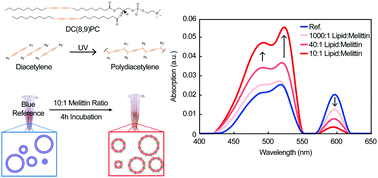Mechanosensitivity of polydiacetylene with a phosphocholine headgroup
Abstract
We have demonstrated colorimetric and fluorescence detection of a peptide, melittin, based on polydiacetylene (PDA) made of 1,2-bis(10,12-tricosadiynoyl)-sn-glycero-3-phosphocholine (DC(8,9)PC). The PDA used in this work has a phosphocholine headgroup, which mimics peptide–cell membrane interactions better than the conventional PDAs with carboxyl headgroups. The dose curve (colorimetric response vs. melittin concentration) showed a half maximum response at the melittin concentration of 0.1 mg ml−1, which is similar to that reported in traditional PDA assays. It suggests that the replacement of the headgroup was achieved without sacrificing the sensitivity. From the dose curve, the Hill coefficient was extracted as αHill = 2.1. The value is in agreement with the results from previous melittin studies with phospholipids, which reflects the benefit of having a biologically relevant headgroup. In addition, we found an unexpectedly slow spectral change when DC(8,9)PC-PDA was incubated with melittin. The origin of the time-dependent signal was studied by combining UV/VIS spectroscopy, fluorescence spectroscopy and dynamic light scattering.



 Please wait while we load your content...
Please wait while we load your content...